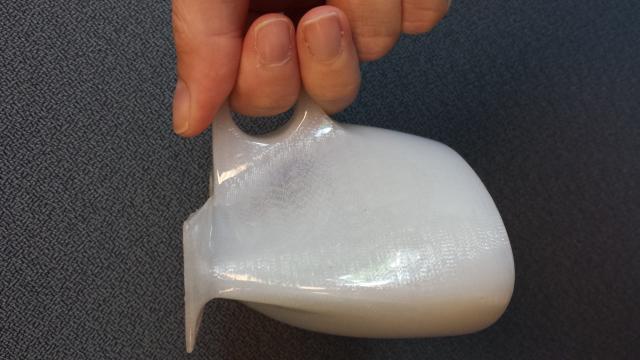Last week the International Space Station got a special delivery: An Italian astronaut arriving at the station brought along a gift in the form of the first espresso machine in space. But enjoying espresso in zero gravity is easier said than done — and a team of Portland-based coffee fans (and physicists) have developed a special cup for the stuff.
Aboard the ISS, astronauts are sipping their espresso through straws attached to plastic pouches, the vessels developed through a collaboration between an Italian engineering team and the coffee company Lavazza. As any snob worth their weight in beans obviously knows, a plastic pouch and a straw are NOT ideal methods for enjoying espresso. Part of what makes a great (tiny) cup is the crema that forms on the top — caused by the emulsified oils that rise to the top thanks to gravity, creating that silky light brown layer of foam-ish stuff above the espresso itself.

The ISSpresso pouch. Picture: DesignBoom.
Obviously, in microgravity, there can be no crema. And without gravity, a fine china cup and saucer are also out of the question. But a group of engineers in Portland are questioning the idea that astronauts must suffer through the indignity of the pouch. In a paper called The Capillary Fluidics of Espresso, presented at the 67th Annual Meeting of the APS Division of Fluid Dynamics before Thanksgiving, they present an alternative design and a 3D-printed prototype of a cup that would preserve just a little bit of the authentic espresso experience in space.
I got in touch with one of the paper’s authors, Portland State University’s Mark Weislogel, for an explanation on how the cup works. According to Weislogel, it’s all about using surface tension to pull the espresso along the walls of the cup towards the opening. You’ll notice the unusual folded geometry of the vessel — those corners are a crucial part of what brings the espresso to the drinker’s mouth, by exploiting their abilities as “capillary wicks,” which draws the coffee along the walls of the container as the drinker sips. When you bring it to your lips, he explains, “it makes a capillary connection such that when you remove liquid into your mouth more liquid is drawn along the interior corner in a way of resupply.”

So you won’t necessarily get to enjoy your crema in exactly the same way, the tactile sensation of drinking from the cup will feel more familiar. Weislogel also explained how the group tested their prototypes: Using a drop tower. And tests also revealed that the cup doesn’t just work for espresso — it would work for all manner of drinks, “from tea with milk, to espresso, to peach mango smoothies.”
And now that the ISS has a 3D printer, it wouldn’t be hard to print out the prototype, should the ISS crew tire of the baggy-plastic-pouch-of-hot-liquid situation. [APS]
